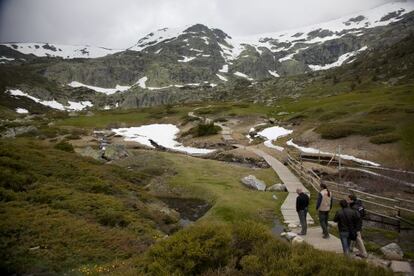The unique blooms of Peñalara
Madrid's new National Park ranks second in the country for biodiversity

The massif of Peñalara is not only the highest peak in the Madrid region at 2,430 meters, but also in the newly created Sierra de Guadarrama National Park, which the Prince and Princess of Asturias inaugurated two weeks ago. The mountain flora that blooms up there - where in June temperatures may still be zero Celsius, though frequent high winds make it feel more like 12 below - renders it even more special.
As many as 365 species populate this beautiful and hostile environment. They range from the 300 different varieties of lichens that one nature buff counted there, to the mountain saffron - common throughout the central and eastern peninsula - and the snow narcissus and its cousin the rock narcissus. Then there are the armerias (sea pinks), which are not necessarily pink but a variety of reddish tones.
"There is such variety here in a small space, so many different habitats that result from glaciation," says José Luis Izquierdo, the park's botanist. "You have all sorts of nooks and crannies in this topography: rock walls, screes, tarns, each with its microclimate. This is why the park ranks second in terms of variety in the National Park network, after the Picos de Europa. The biodiversity is really amazing, considering it is concentrated in a relatively small space."
The explanation for this natural wealth - where the mild-mannered, modest amphibians are one of the jewels of the ecosystem - is a climatic cocktail that you don't encounter every day: continental, cold, northern, yet with a summery-Mediterranean touch that tends to confuse. "To all this you can add the drawbacks of the summer drought, which is not the case in the Pyrenees and the Cantabrian system, whose floral range extends to the Guadarrama. And the difficulties of the prevailing west wind. They have to adapt to it."
The biodiversity is really amazing, considering it is concentrated in a relatively small space"
In view of these adaptation difficulties, the Madrid regional government is giving careful consideration to what the visitor policy should be in this park that straddles the Guadarrama range, which forms the border with Castilla y León. "We have placed counters on some of the most frequented trails so that, should the volume of visitors endanger conservation, we may close one trail and divert traffic to others," explains the head of the regional environment department, Borja Sarasola. "Conservation is the priority; but it has to be compatible with a certain amount of tourism and mountain-climbing." Indeed, picking flowers is prohibited throughout the park.
Peñalara is a place where appearances can be deceptive. Here you see daisies, which to the layman look much like those you might see growing in any vacant lot in the city. But "they are totally different from the daisies you find down in the valley," says Izquierdo, explaining that they have a woody stem, are mildly aromatic, and are also capable of surviving in the high mountains. "It's a very rare plant in this ecosystem. At first sight these daisies may be nothing special, and smaller than usual, but up here everything is small on account of the harsh conditions," he adds. The wind-blasted crowns of the pines, some twisted into Gordian-style knots, speak eloquently of the grim winters here.
Among the other specialized ecosystems in Peñalara are the moist meadows, ponds and peat bogs that occupy part of the cirque. Several botanical jewels have chosen this cold wet place as their habitat, including inundated clubmoss ( Lycopodiella inundata ), which is recognized as an endangered species.There are also carnivorous plants, such as the common sundew ( Drosera rotundifolia ), the large-flowered butterwort ( Pinguicula grandiflora ) and the lesser bladderwort (Utricularia minor), which is adept at underwater fishing, capturing small invertebrates.
These ponds are the crown jewels of the National Park"
"These ponds are the crown jewels of the National Park," the botanist adds.But for all the connotations of danger in the word "carnivorous," these ecosystems are vulnerable, and one of the reasons loose dogs are not allowed in the cirque is so they won't go romping around in the ponds. "There are many dogs that love water, such as golden retrievers, but they have to be kept on a leash, because they may have pollutants on their paws, which are dangerous to the amphibians," explains a warden, who adds that until recently, swimming competitions used to be held in some of the ponds. Several pairs of wardens now stand watch to prevent such acts of violence against the complex laws of this small natural province. The fines are fairly dissuasive.
The elimination of the ski slopes that consumed much of the cirque of Peñalara is another blessing. And now, as a result of such efforts, the terrain is beginning to recover from its wounds. "Restoration of plant cover is not a general practice in these cases, but this is what we have done, using only autochthonous plants, to conserve genetic purity," they say, with pride, at the visitor center in Cotos.
Tu suscripción se está usando en otro dispositivo
¿Quieres añadir otro usuario a tu suscripción?
Si continúas leyendo en este dispositivo, no se podrá leer en el otro.
FlechaTu suscripción se está usando en otro dispositivo y solo puedes acceder a EL PAÍS desde un dispositivo a la vez.
Si quieres compartir tu cuenta, cambia tu suscripción a la modalidad Premium, así podrás añadir otro usuario. Cada uno accederá con su propia cuenta de email, lo que os permitirá personalizar vuestra experiencia en EL PAÍS.
¿Tienes una suscripción de empresa? Accede aquí para contratar más cuentas.
En el caso de no saber quién está usando tu cuenta, te recomendamos cambiar tu contraseña aquí.
Si decides continuar compartiendo tu cuenta, este mensaje se mostrará en tu dispositivo y en el de la otra persona que está usando tu cuenta de forma indefinida, afectando a tu experiencia de lectura. Puedes consultar aquí los términos y condiciones de la suscripción digital.
Últimas noticias
Most viewed
- Pablo Escobar’s hippos: A serious environmental problem, 40 years on
- Why we lost the habit of sleeping in two segments and how that changed our sense of time
- Charles Dubouloz, mountaineering star, retires at 36 with a farewell tour inspired by Walter Bonatti
- Reinhard Genzel, Nobel laureate in physics: ‘One-minute videos will never give you the truth’
- The Florida Keys tourist paradise is besieged by immigration agents: ‘We’ve never seen anything like this’









































